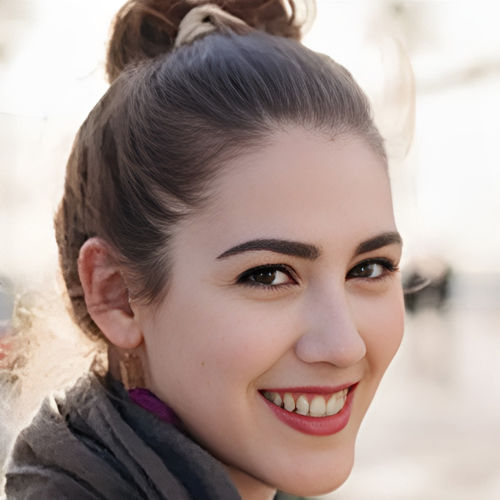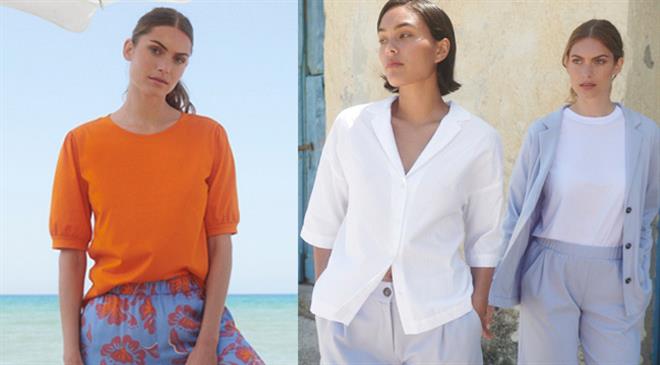
Elena Panagopoulos
Designer
Brand - Hanro
True luxury means feeling completely comfortable in your skin
The unmistakable creations of the premium lingerie manufacturer HANRO come to life in a small town in Vorarlberg, Austria, near the Swiss border. A team comprising of product management, product development, and design create unique styles in HANRO’s typical streamlined design language day in and day out. Many prints and embroidery are drafted by the designers exclusively for HANRO. The brand’s Designer Elena Panagopoulos talks to Fibre2Fashion about designing for loungewear and nightwear.
Fibre2Fashion: What is your design philosophy and how does it influence your collections?
Elena Panagopoulos:
The design of HANRO products is timeless, puristic, elegant, and chic. Nevertheless, we also work with elaborate, special details such as lace, embroidery and prints, but are never overloaded. What makes the design also special is durability, not only in terms of quality, but also in terms of style. We want to develop favourite pieces that one can wear over several seasons, several years, and sometimes even several decades.
F2F: How would you define the aesthetic and style of Hanro collections?
EP:
F2F: How do you balance between comfort and fashion in loungewear design?
EP:
HANRO combines modern, elegant design with extraordinary comfort. Whether you are at home, in the city, in the office, or going out at night, our versatile loungewear styles will help you create timeless looks while feeling comfortable from day to night. But, of course, comfort is the key. So, this feeling of comfort is one of the most important things for us, which means we do not make any compromises; for example, even if we like something super well in the design and it is just scratchy or stiff, then we would not use it.
F2F: What makes Hanro stand out amongst the plethora of leisurewear brands in the market?
EP:
Nightwear is not only worn for sleeping, and loungewear is no longer only for cozy times on the sofa. The boundaries between office, home, and leisure are increasingly overlapping. Working from home has become the new normal. The demand for loungewear is growing and consumer requirements are high – the motto is “stylish and comfortable”. Today, not only should loungewear be comfortable, but it also has to be suitable as outerwear too. HANRO recognised this need very early on. So, we have a variety of styles in our collection that easily bridge the gap between home office, a leisurely walk, and a shopping trip. Our brand has always deemed loungewear as an integral part of every collection and now more than ever, high quality, comfortable clothes have taken priority. Customers appreciate these timeless, versatile basics; they are making much more conscious buying decisions these days and want to enjoy their new purchases for a long time to come.
F2F: How do you stay in sync with current trends in the loungewear market?
EP:
We look for our inspiration and information in different corners. For example, we work with renowned trend researchers and trend books to stay up to date with the latest news in terms of cut, colour and details. We also have the opportunity to make several inspiration trips every season to see what is happening in other countries and capitals. We also work closely with our suppliers who share with us the latest trends in fibres and yarns, because innovation very often comes from fabrics.
F2F: Can you walk us through your design process from concept to the finished product?
EP:
After gathering inspiration at fairs, city trips, museums and so on, we determine the colour themes of the collection. Then we start to allocate fabrics, lace and embroidery to certain products. Sometimes we also develop laces or embroideries ourselves. And we create the prints by ourselves; we have an in-house print designer who draws all the prints by hand. In the next step, I start with the drawings. We still work a lot with hand drawings. Then, we do draping on the bust to see how the fabric falls. From the hand drawings we create technical drawings on the computer. Once that is done, we hand the collection over to our product development and pattern team to proceed with producing the products.
F2F: What challenges did you face in your design career and how did you overcome them?
EP:
F2F: Please tell us about any of your memorable or successful creations.
EP:
HANRO was awarded with the ‘Designer of the year’ Award in Paris in 2016. For this occasion, my colleague and I created a small high-end capsule collection, which was presented on site at a fashion show. For this occasion, we were completely free in our creation and were allowed to work without any restrictions in terms of realisation or pricing.
F2F: How do you incorporate sustainability into your designs and production processes?
EP:
High-quality natural materials are our standard. Certificates, strict quality controls, innovative finishing processes and production in Europe are the secret of our durable products. At the heart of our sustainability strategy is the manufacture of high-quality products with a long lifetime. Because the longer our products are worn, the better for the environment. We are continuously working on innovative and sustainable solutions in regard to new materials such like TENCEL Lyocell fibres, organic cotton, or innovative milk fibre.
F2F: How do you see the loungewear market evolving in the future? How do you plan to stay ahead of the curve?
EP:
I see both the segments (loungewear and nightwear) and the seasons merging more and more. The lines are no longer clear. Our customers want to decide for themselves how to wear a garment. We see this in our team as well, everyone has different needs, and everyone combines individually. I think it is becoming more and more important to develop versatile pieces that work across seasons, especially with the idea of sustainability, which is becoming even more important in the textile sector. I think it is very important to always stay open to new ways and not to close yourself out of habit.
F2F: How do you make your collections inclusive and accessible to a diverse range of customers?
EP:
We try to include pieces in our collection that are gender neutral and can be combined individually. We also think very globally when developing our collection, as we sell in many different countries with different climates and different needs.
F2F: What advice would you give to aspiring designers?
EP:
If you are convinced of an idea, stand up for it. It can often be very tiring when you present new ideas and do not manage to inspire the decision-makers directly. As a designer, you always work with the future in mind, you often have to meet the parties involved in the creation process first, so that they can properly classify your ideas. But if your heart burns for something, it is usually the right way to go, then it is worth going the extra mile.

Pradip Mehta
Anurag Batra
Abhay Gupta
Fanny Vermandel
Gabi Seligsohn
Rahul Mehta
Bill D’Arienzo
Rahul Mehta
Aseem Prakash
Arun Sirdeshmukh



20230103183907.png)







_8.JPG)



